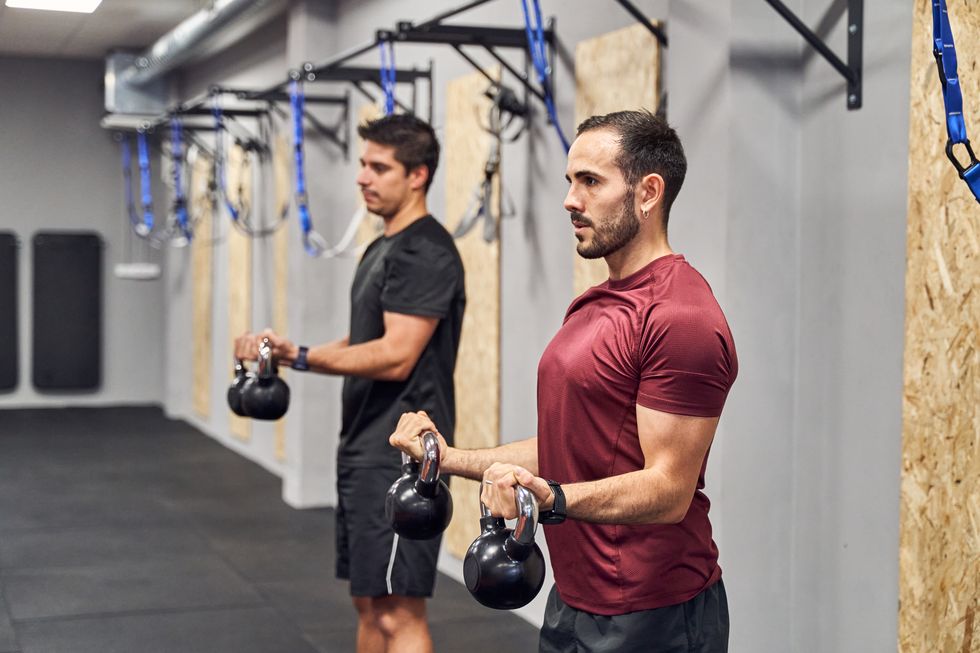The following is an excerpt from the new Men’s Health training guide 90-Day Transformation Challenge: Arms. In one volume, you’ll get all the tools you need—information, a nutrition guide, and workouts—to build your arms in just 3 months.
GETTING A PLAN is one thing. Following that plan through to its end is a completely different task. We’ve all had that workout plan, nutrition advice, or cardio routine that we hoped would get us on track with the version of ourselves we want to become. Finding a plan isn’t the part people have trouble with: It’s the follow-through, sticking with the program every day.
I get it! Most people start new programs with the best of intentions, but then life gets in the way. Late hours for a work project, a sick child, feeling overwhelmed, or any number of monkey wrenches can derail the program, and sometimes you never get back on track. This is the pain point that keeps many people from making the changes they initially set out to accomplish.
Luckily, that is all in the past. Here are the top tricks and hacks I suggest to my clients to help them go from well intentioned to well equipped!
1. Choose Small Goals, or Mile Markers, to Achieve Along the Way
We all have goals we want to achieve. But often we look at the goal and it feels almost insurmountable—too big to ever accomplish. I can’t count the number of times I have heard a client say “I could never do that” before we started working together. The sad part is we tell ourselves that so much we actually begin to believe it.
Instead of trying to conquer the world of health and fitness in one grandiose act, begin with small wins. Small wins build momentum and your confidence, giving you the capacity to achieve truly great things.
Say, for example, you want to do a pullup. You can’t just grab the bar, hang there every day, and eventually pull yourself up—it’s asking too much of your body. Instead, use a progression: Start with grip strength, then work on your back strength, move onto assisted pulls, and eventually you’ll complete a full pullup. Deconstruct the move into its component parts, then work in very deliberate steps, attacking it one step at a time until you’ve mastered it.
It’s the same with this plan. Building muscular arms will take some time. But don’t feel overwhelmed: Just take a deep breath and trust the process.
How we address this in the program: Most people abandon their programs because they don’t see results quickly enough; their idea of progress is simply too ambitious for the amount of time they’ve allotted for it. In this program, you’ll notice that we change one variable at a time. We’ll add a set to the exercise, reduce the rest interval, or make a change to the exercise. This means the goals of volume, conditioning, or progression all happen in small increments.
2. Make the Plan Fit You
Don’t try to fit a square peg into a round hole. Exercise programs come in all different schemes, modalities, progressions, etc. There are endless variations and types. To be honest, there is more than one way to get it done!
It’s important to find a plan that can fit your ability, the amount of time you have, and your schedule. In fact, it’s key. And I’ve found that people realize this. In fact, one of the most common questions I get is, “What is the ideal workout schedule?”
Unfortunately, I can’t answer that question with a list of days and times, or exactly timed minutes of deadlifts.
A recent study compared muscle hypertrophy (or growth) in participants who did resistance training six days a week versus those who did three days a week. They found when volume was equal, results were similar.
What should this tell you? When it comes to exercise, you can’t apply the “more is better” mentality that might work in other areas of life. With exercise, better is better.
Should I work out in the morning or at night? Work out when you have the most time and energy. Should I do cardio first or lift first? Do them in the order you are most likely to accomplish them. How much weight should I lift? As much as you can while maintaining proper form. Embrace working in the conditions that work for you.
How we address this in the program: The program is created so it won’t take up your entire day.
The challenges are short enough to squeeze in during your off days, and the base workout-challenge combo planned for 4 days per week only takes about 45 to 60 minutes to complete. It’s flexible so you can do this at your preferred time of day—no quitting your job or taking days off to take part!
3. Build Solid Long-Term Behaviors
It’s not just about committing to the plan for 90 days but also creating an environment you can continue to thrive in past this point. The goal is to purposefully make fitness and health your top priority.
Most people have gone on diet plans or workout routines that were, simply put, grueling. You may have gotten short-term results. But did they last? Most times, they don’t. That is because the program wasn’t fixing the root of the problem, which is your everyday behaviors.
With this plan, each week emphasizes a specific behavior goal to help ensure this 90-day plan becomes a life-long adventure.
How we address this in the program: Each week, you will be given habit goals to work on. These are the long-term qualities that round out your fitness to support your physical demands. As with my first tip, these will be small mile markers. Focusing on one at a time will leave you with a different mindset at the end of the 90 days. You could see a completely different version of yourself in just three months.
4. Create Enough Variety to Keep it Interesting
There is a sweet spot with variety in programming. If you do too much of the same thing over and over again, it can become a very boring pursuit with diminishing gains. But if you change things up every single time, you will be creating a moving target, making it almost impossible to see any real hypertrophy or physique changes.
A recent study on exercise variation and its effect on hypertrophy and strength gains found that both redundancy (repetition) and excessive variation interfered with strength and hypertrophy. After reviewing current studies, researchers suggested “the exercise variation can be focused on including exercises that have similar movement patterns to the main exercise and inducing muscle hypertrophy on prime mover while decreasing joint stress.”
What does that mean? To accomplish the best results, you need the right amount of variation to address complementary muscles, slight variations in movement demand, and more advantageous positions to continue strength and hypertrophy.
How we address this in the program: Small subtle changes in how you perform an exercise make a big difference in the long run. Even small adjustments, like slight turns of the
hand position can change the muscular emphasis on biceps and triceps exercises, creating just enough variety to keep the movement fresh and the results coming. Additionally, we add exercise techniques such as tempo changes, rest changes, and volume increases to further challenge the muscles.
5. Don’t Beat Yourself Up
You will have days where you feel amazing—like a superhero—and days where you feel completely mortal, or even worse. It happens. And, to be honest, it’s part of the reason some people start to lose interest or even quit their program.
Always remember: If you fall off the wagon, you can climb back on. If you miss a workout or two, or just have a bad day at the gym, that doesn’t mean you should trash the whole program. You can resume it where you left off or a little earlier. Reset and get back to what you are looking to accomplish. Whether you’ve missed a workout, ignored your diet plan at dinner, or didn’t get the sleep you need, don’t beat yourself up. Just reset and restart.
How we address this in the program: Life happens. Committing to the 90-Day Challenge is the first step, but I also understand that life can change quickly or some sections of this program may be more difficult than you originally bargained for. If, at the end of one phase you find yourself feeling especially fatigued or burned out, you can always restart the previous phase. The goal is to complete this in a timeline that makes sense for you.
David Otey, CSCS is a fitness writer, NYC-based strength coach, and Men’s Health Advisory Board member who specializes in strength and hypertrophy protocols as well as athletic performance. For more on Otey check out www.oteyfitness.com.




Comments are closed.